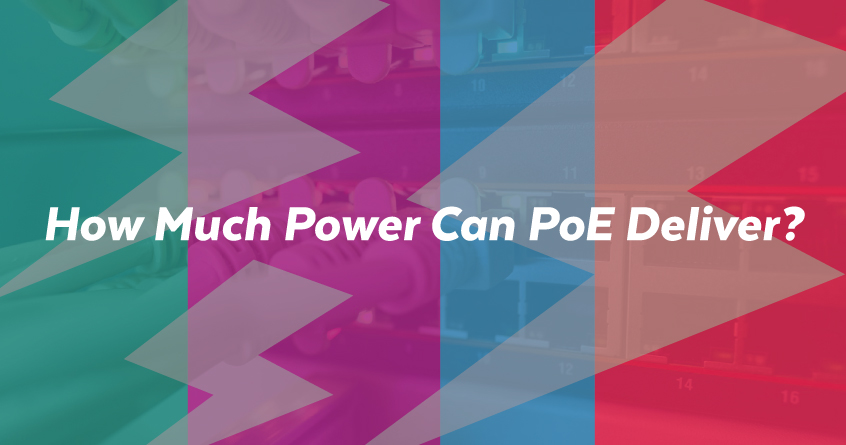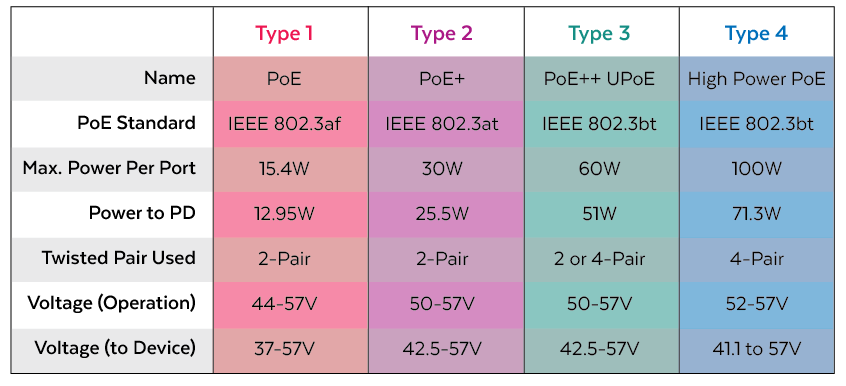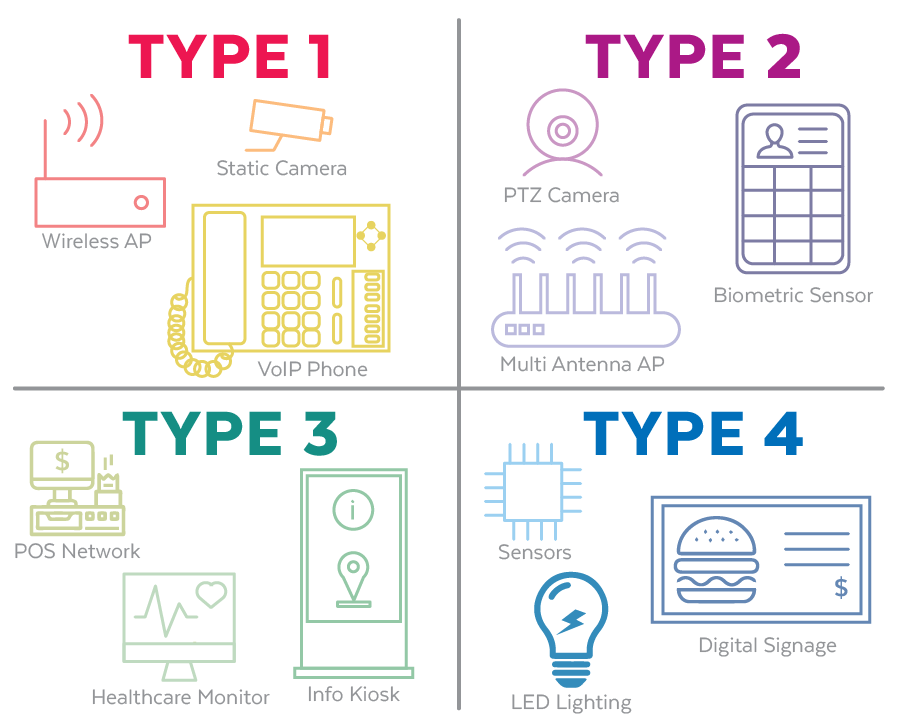When considering a Power Over Ethernet (PoE) switch, questions concerning power capability and accessibility always arise. There are four types of Power over Ethernet standards within the 802.3 Ethernet protocol. Each standard has a different power budget and supports various types of devices.
What is PoE?
PoE refers to an electrical standard that can be used to transmit power and data over a single Ethernet cable. With PoE technology, pairs of twisted wires within a copper cable can support both applications. PoE allows for network installation of powered devices in locations that lack electrical circuitry or are difficult to wire, such as ceilings.
Some typical applications of PoE technology include:
- Wireless access points.
- VoIP phones.
- IP cameras.
- Security card readers.
- ATMs.
- PoE lighting.
PoE is relatively simple to deploy and eliminates the expense of hiring an electrician to install additional electrical wiring.
What are the benefits of PoE switches?
Traditional switches require two cables: one for power and one for data. They cannot supply power for end devices over Ethernet.
PoE switches minimize cable usage by supplying power and data via one cable. This minimization saves costs on power outlets, electrical installation, and infrastructure equipment.
PoE provides:
- Flexible placement options to allow for deployment in complex environments.
- Intelligent protection of devices from power surges.
- Maximization of power usage efficiency.
- The ability to support an increasing number of connected devices.
PoE is a cost-effective solution that simplifies installation and streamlines power deployment. It makes it easy to expand a network for minimal investment.
What are the four types of PoE?
PoE standards are set by the Institute of Electrical and Electronics Engineers (IEEE). Currently, four types of PoE are available: IEEE802.3af, IEEE802.3at, and IEEE802.3bt, which has been divided into two types.
Type 1
Known as Standard PoE, the IEEE 802.3af standard supports 15.4W of power per device, though powered devices (PDs) can receive only 12.95W of power due to power dissipation. Type 1 contains two twisted wires within a copper cable and operates at 44V to 57V. The voltage range delivered to devices is 37V to 57V.
Type 2
Also known as PoE+, the IEEE 802.3at standard supports 30W of power per device, with power dissipation causing PDs to receive 25.5W of power. Type 2 contains two pairs of twisted wires, as well. The voltage range is 50V to 57V, with devices receiving 42.5V to 57V.
Type 3
Referred to as Universal Power over Ethernet (UPoE) and PoE++, the Type 3 IEEE 802.3bt standard supports 60W of power per device. It contains either two pairs of twisted wires for classes 0 to 4 or four pairs of twisted wires for classes 5 and 6 within a single copper cable. Connected PDs receive 51W of power. The voltage range for Type 3 PoE is 50V to 57V. Devices receive 42.5V to 57V.
Type 4
Known as Higher Power PoE, Type 4 contains four pairs of twisted wires for classes 7 and 8. As the second of two IEEE 802.3bt standards, Type 4 supports 100W of power per device. This PoE standard dissipates on the receiving end to 71.3W of power. The voltage range is 52V to 57V, with devices receiving 41.1V to 57V.
The Powered Devices Each Type of PoE Supports
The most significant differences between types of PoE switches lie in their working modes and power supply. These differences are also reflected in their applications.
Primarily used to connect many low-powered devices to a network, Type 1 PoE can support:
- VoIP phones.
- Simple wireless access points.
- Thin clients.
- Sensors.
- Meters.
- Static surveillance cameras (lacking tilt, pan, or zoom features).
Type 2 PoE can connect higher-powered devices to a network. These include:
- More complex surveillance camera systems that pan, tilt, and zoom.
- Alarm systems.
- Radio-frequency identification (RFID) readers.
- Wireless access points with six antennas.
- Biometric sensors.
- LCDs.
- Tablets.
- IP telephones that offer voice calls, fax, and text messaging.
Type 3 PoE can support:
- Video conferencing system components.
- Information kiosks.
- Building management devices such as door controllers and gates.
- Point of sale networks.
- Remote systems for monitoring patient vitals in a healthcare facility.
Type 4 PoE is used to support:
- High-power wireless networks.
- LED lighting and sensors.
- Televisions.
- Advanced video conferencing systems.
- Digital signage.
One important note to consider is that a higher power budget is required to power most smart technologies.
PoE Power Levels – How to Determine Which to Use
Choosing a PoE type depends on several factors, including:
- The types of devices being connected to the PoE switch. Simple devices, such as VoIP phones and stationary surveillance cameras, often have lower minimum power and data requirements than those with high demands, such as high-power wireless networks or sophisticated video conferencing systems.
- The power requirement of all devices being plugged into the switch. Type 1 supports up to 15.4W, type 2 up to 30W, type 3 up to 60W, and type 4 up to 100W. Determine the total power needed and choose a standard that can handle that capacity.
- The distance between the powered device and the PoE switch. The distance between a PD and a PoE switch will affect the amount of power that is delivered. Long distances may require a higher PoE type or the addition of a PoE extender.
If you are still trying to decide which PoE type would be best for your facility, know that the ideal scenario involves exceeding your power requirements. This way, you won’t be required to limit the number of connected devices and will be ready to expand your network should the need arise. To determine a suitable PoE power level for your situation, ensure the products you choose can adequately cover your current system and consider future growth to determine an appropriate PoE power level.
Consult with a trusted supplier of PoE technology for more information or to discuss your particular PoE requirements.


